Quan Thanh Temple is the most sacred ancient temple in Hanoi, Vietnam. With its unique architecture, valuable artifacts, and rich historical stories, Quan Thanh Temple has become an indispensable historical monument when visiting the capital city of Hanoi.
Table of Contents
Quan Thanh Temple – General Information
Where is Quan Thanh Temple Located?
Quan Thanh Temple is situated at the intersection of Thanh Nien Street and Quan Thanh Street, across from West Lake. Alongside Tran Quoc Pagoda, Kim Lien Pagoda, and others, this temple has become a renowned spiritual destination in Hanoi, attracting numerous visitors from various places who come to visit and offer their respects.
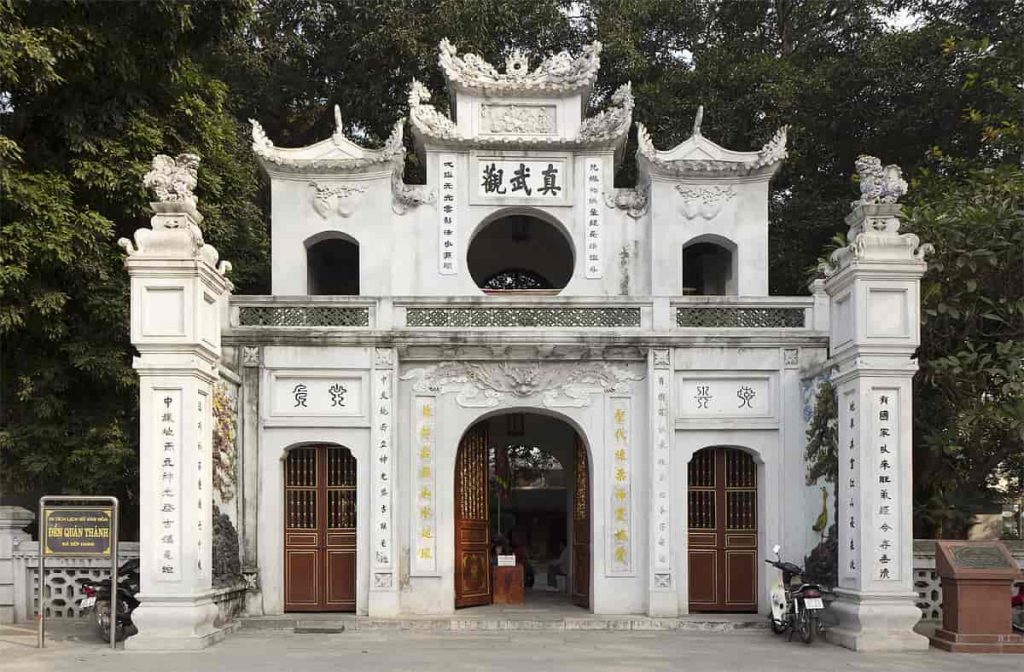
To reach Quan Thanh Temple, you can choose personal transportation such as a car or motorbike, or use public transportation, specifically buses. Quan Thanh Street is centrally located, making it easy to find. From Ba Dinh Square, follow Independence and Hoang Van Thu Streets, then turn onto Hung Vuong Street and continue for about 400 meters. If you prefer to take a bus, you can choose routes 14, 33, or 50.
Additionally, for a more comfortable sightseeing experience, you can book a private car with a driver in Hanoi from DanangPrivateCar.com’s. With our private car service, you won’t need to worry about navigation or public transportation. Your only task is to provide your pickup address, and our professional driver will ensure a quick and safe journey. Furthermore, if you have extra time to explore other places while visiting Quan Thanh Temple, having a private car allows you to customize your own itinerary.
Who is Quan Thanh Temple Dedicated To?
The name “Quan Thanh Temple” derives from a mispronunciation of “Quan Thanh Tran Vo,” also known as “Tran Vu Quan.” This temple venerates the deity Tran Vu, the guardian of the northern gate of the ancient Thang Long Citadel, who is also known as Huyen Thien Tran Vu.
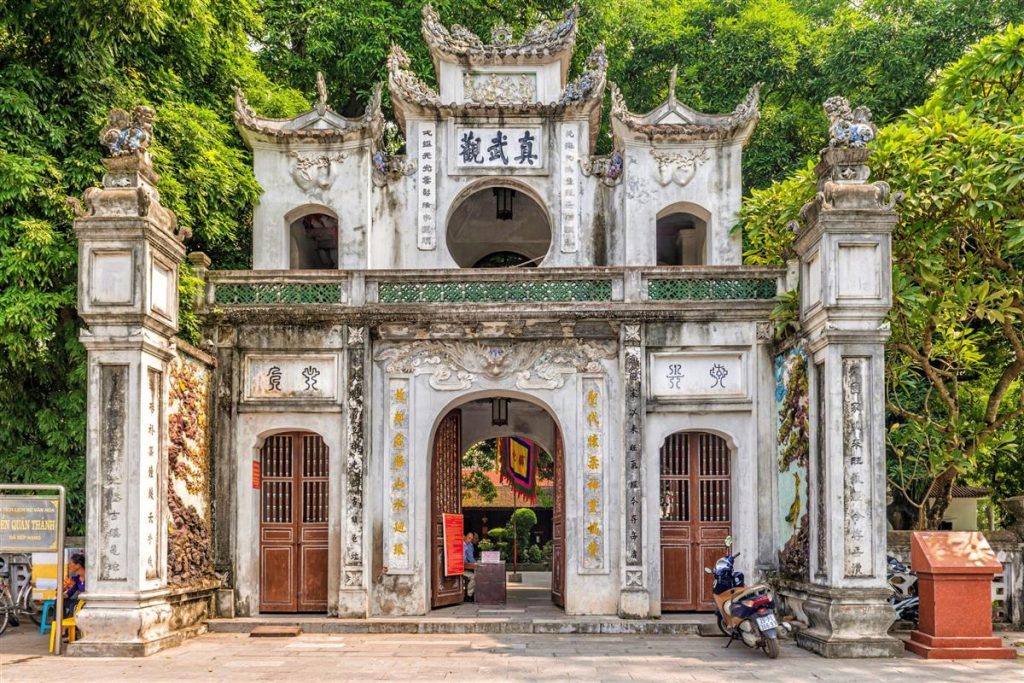
Ticket Prices and Opening Hours of Quan Thanh Temple
Quan Thanh Temple is open every day of the week from 8 AM to 5 PM. During the Lunar New Year’s Eve and on the 1st and 15th day of the lunar month, the temple stays open overnight, from 6 AM to 8 PM. The ticket prices for entry to worship Huyen Thien Tran Vu are 10,000 VND per adult and 5,000 VND per student or child. To fully enjoy your visit and offerings, plan your time accordingly.
When is Quan Thanh Temple Festival Celebrated?
The Quan Thanh Temple Festival is held annually on the 3rd day of the 3rd lunar month (according to the Vietnamese lunar calendar). It attracts a large number of people who come to make offerings, seek blessings, and good fortune. In addition to this festival, people often gather at the temple during the first days of the lunar new year, approximately from the 1st to the 15th day of the 1st lunar month. If you plan to visit Quan Thanh Temple during these times, make sure to schedule your visit accordingly.
History and Legend of Quan Thanh Temple in Hanoi
History of Quan Thanh Temple
According to historical records and inscriptions found on stone steles, Quan Thanh Temple was built during the reign of the Ly dynasty. It underwent several renovations in the years 1618, 1677, 1768, 1836, 1843, 1893, and 1941. The major renovation took place during the reign of King Le Hy Tong in the year Dinh Ty, under the supervision of Trinh Can, who was entrusted by Trinh Tac to oversee the casting of the bronze statue of Huyen Thien Tran Vu and the guardian deity Tran Vu. The artisan Vu Cong Chan was directly responsible for casting the Huyen Thien Tran Vu statue in bronze, replacing the previous wooden one.
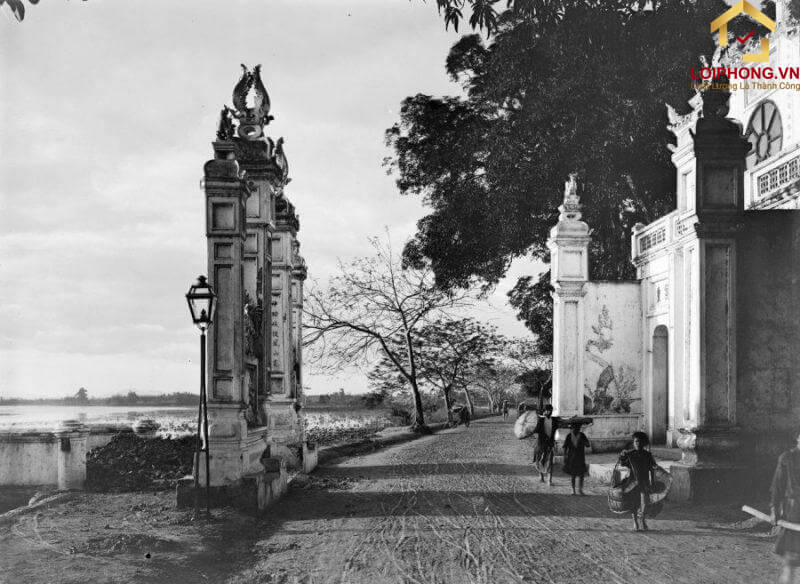
In 1794, during the reign of King Canh Thinh, Tây Sơn Governor Le Van Ngu had a large bronze bell cast and placed it in the main hall of the temple. When King Minh Mang conducted an inspection tour of the Northern Citadel, he renamed the temple to “Chan Vu Quan.” These three Chinese characters were carved on the roof of the three gates, but the main altar inside the Bai Duong remained dedicated to Tran Vu Quan.
In 1872, during the reign of King Thieu Tri, the temple received royal funds to cast a ceremonial bell, which was then hung on the statue of Tran Vu. In 1962, the temple was officially recognized as a national historical and cultural relic, alongside Tran Quoc Pagoda.
Therefore, both names, Chan Vu Quan and Quan Thanh Temple, have been historically accepted. “Quan” means Daoist Temple and is a place of worship in Daoism, similar to how “chua” is associated with Buddhism.
Legend of Saint Tran Vu
Saint Tran Vu is a legendary figure in Vietnamese and Chinese mythology, leading to two distinct legends about this character.
In one version of the legend, Huyen Thien Tran Vu was a deity assigned to guard the northern gate of Heaven during the time of the Tuy dynasty. Later, he descended to Earth, reborn as the son of the king of Tinh Lac in ancient China. Upon reaching adulthood, he renounced worldly power, silk garments, and royal privilege to pursue a life of meditation on Mount Vu Duong. After 42 years of rigorous meditation and self-cultivation, Huyen Thien Tran Vu attained enlightenment and ventured into Vietnam.
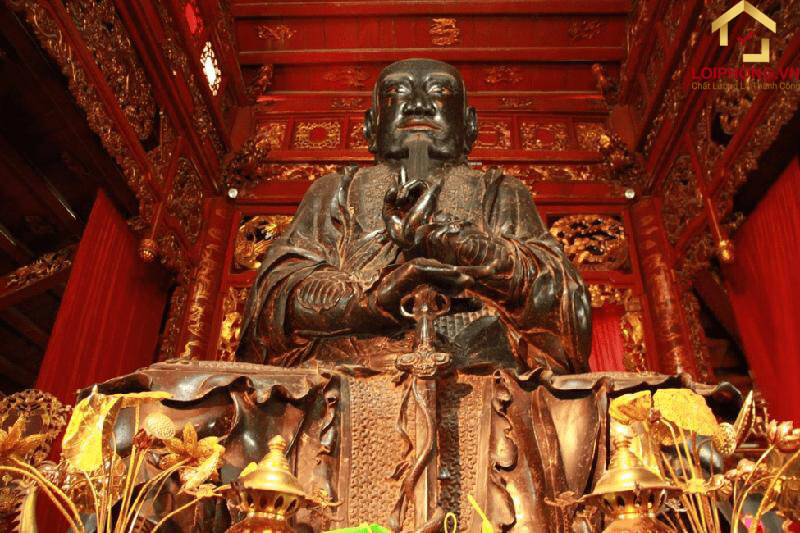
When he arrived in the village of Do Long, along the Nhị Hà River (present-day Hanoi), he decided to settle and practice at the temple near West Lake. Thanks to his advanced spiritual powers, he defeated demons and protected the local villagers. In gratitude, the villagers established a temple to worship Huyen Thien Tran Vu right at the temple where he practiced, naming it Tran Vu Quan.
In another version of the legend, Huyen Thien Tran Vu was a celestial envoy sent by the Jade Emperor to vanquish a nine-tailed fox spirit that plagued the lives of the people in the Long Do Village. Consequently, when the capital was moved to Thang Long, King Ly Thai To erected the Huyen Thien Tran Vu Temple in the north to safeguard against malevolent spirits harming the villagers.
You can explore another famous temple in Hanoi: Tran Quoc Pagoda – An ancient temple with a history of over 1500 years.
Exploring the Architecture of Quan Thanh Temple in Hanoi
The architecture of Quan Thanh Temple comprises three gates, a forecourt, a main courtyard, a ceremonial yard, and a rear chamber, all designed in the traditional Chinese architectural style.
The outer gate of the temple, located on Thanh Nien Street, features four back-to-back phoenixes and a pair of kneeling nghê statues at the top of its columns. Surrounding the columns are carvings of fish transformed into dragons, fierce tigers among the mountains, and prominent red couplets.
Behind the outer gate is the triple-entrance forecourt, consisting of two stories and three doors. Notably, at the central gate of the forecourt, there is an elevated statue of the deity Rahu—an Indian god. This detail reflects the integration of beliefs that the Vietnamese people have had for centuries. Additionally, in the main forecourt loft, there is a bronze bell cast during the reign of King Le Hy Tong in 1677. This bell is famous in Vietnamese folklore and poetry, with verses like “The wind carries the bamboo leaves gently. The Tran Vu bell tolls, the rooster crows in Tho Xuong.”
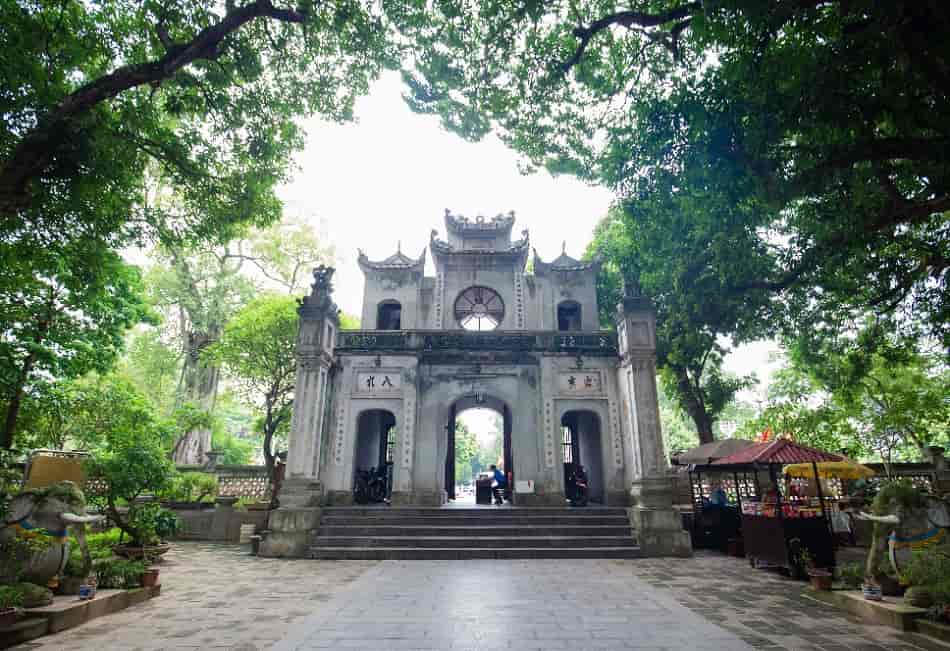
Passing through the triple-entrance forecourt, you’ll arrive at the stone stele house with numerous inscribed steles documenting the various temple renovations throughout history. Behind the stele house is the martyrs’ shrine, built in the form of a square pavilion. Inside, there is an altar and images of the soldiers who sacrificed their lives in wars near Quan Thanh Temple.
The ceremonial yard is where offerings are arranged and prepared. In front of the ceremonial hall, there is a table for preparing offerings and two large incense urns. In the rear chamber, there is an information board introducing the bronze statue of Huyen Thien Tran Vu. On the side of the ceremonial hall, there are sculptures depicting fish transformed into dragons and tigers descending from the mountains. The statue of Huyen Thien Tran Vu is the most unique and outstanding sculptural work in Vietnam. It showcases the exquisite art of sculpting and bronze casting that Vietnamese artists have mastered for over three centuries.

Inside the main ceremonial hall, there is a smaller black bronze statue. Quan Thanh Temple also houses a large bronze bell that was cast during the Trinh Lords’ era. All the statues within the temple are meticulously and intricately sculpted, bearing the artistic imprint of the Lê dynasty era.
Visiting Other Famous Attractions Near Quan Thanh Temple
After paying your respects and exploring Quan Thanh Temple, you can also visit other famous tourist attractions located nearby, such as:
- Ba Dinh Square: Just 2.6 kilometers away, this expansive square is not only a historical landmark but also the site where President Ho Chi Minh read the Proclamation of Independence on September 2, 1945, giving birth to the Democratic Republic of Vietnam.
- Kinh Thien Palace: A mere 2.8 kilometers from Quan Thanh Temple, this ancient palace is an architectural masterpiece in its own right. It is a testament to the grandeur of the Vietnamese royal court during the Ly and Tran dynasties.
- Hang Dau Water Tower: Also located 2.8 kilometers away, this iconic water tower stands as a testament to Hanoi’s colonial history. Its distinctive design and historic significance make it a unique point of interest.
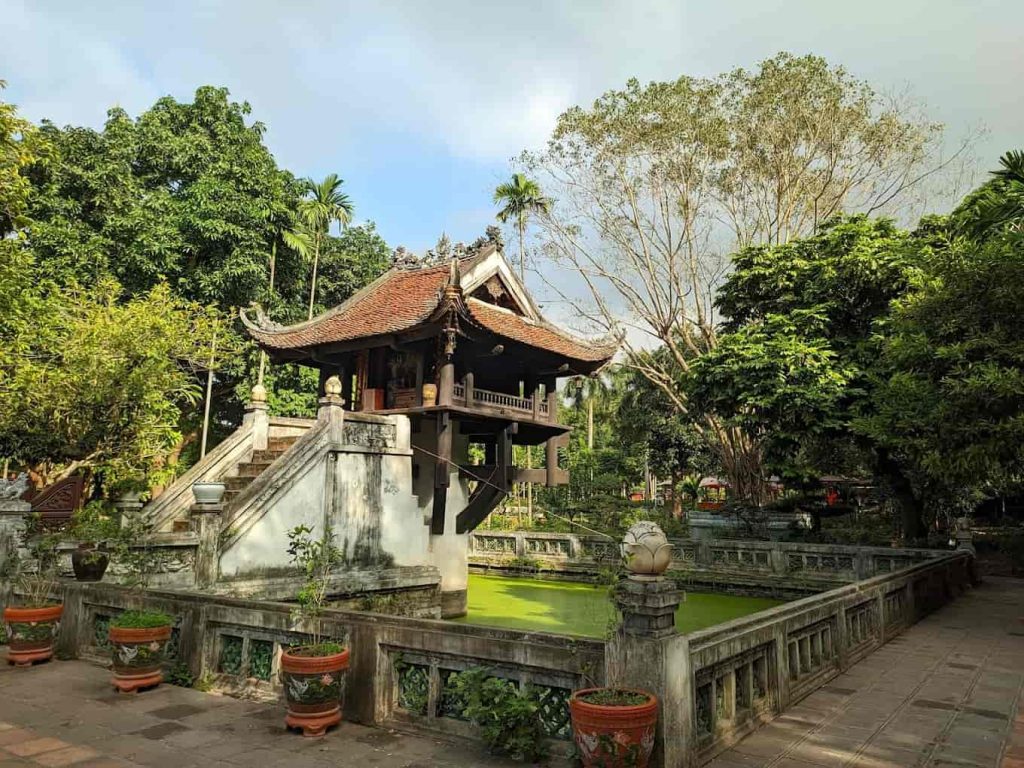
- One Pillar Pagoda: A short 2.9 kilometers away, this iconic pagoda is renowned for its unique architectural design, resembling a lotus blossom emerging from a tranquil pond. It is a symbol of Vietnamese Buddhism and a must-visit site for those exploring the city’s cultural heritage.
Quan Thanh Temple is a renowned cultural and religious site in Vietnam. With its unique and intricate architecture, it stands as one of the country’s significant historical landmarks. Situated in a prime location, Quan Thanh Temple is also an immensely appealing destination for both religious devotees and tourists seeking to explore Hanoi’s traditional culture. When visiting Hanoi, make sure to come and uncover the mysteries of this place and find inner peace and serenity in your soul.

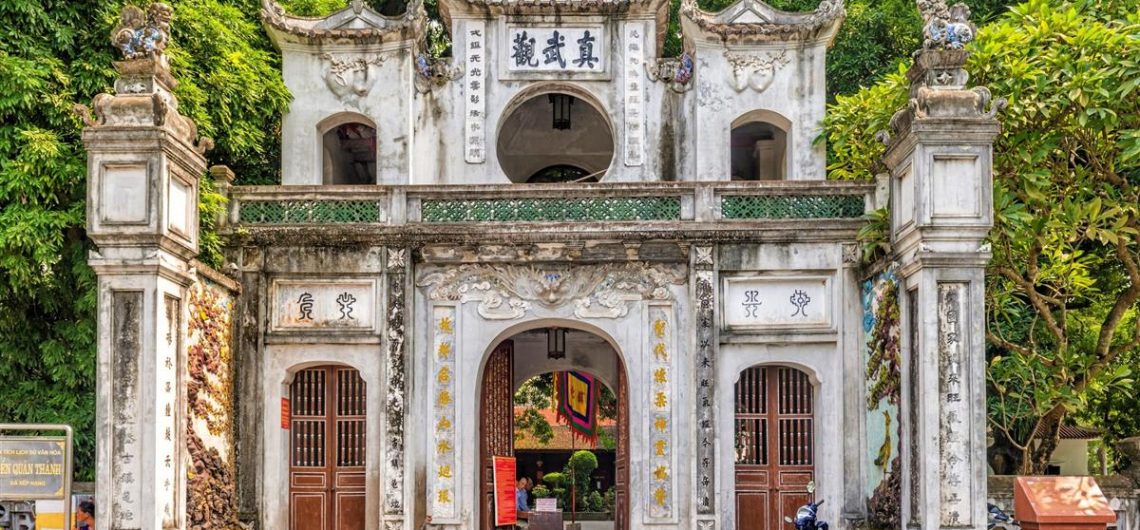
Comments